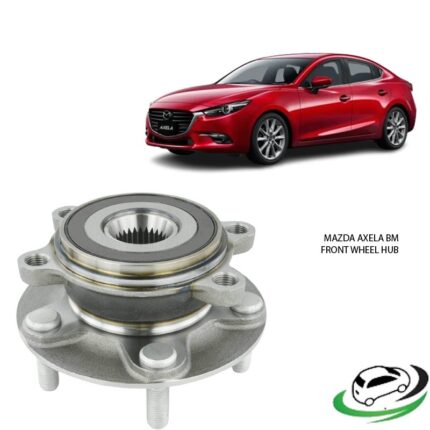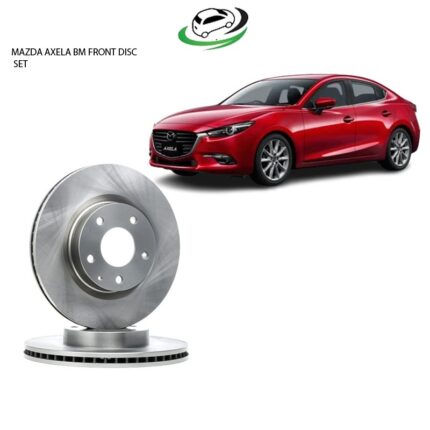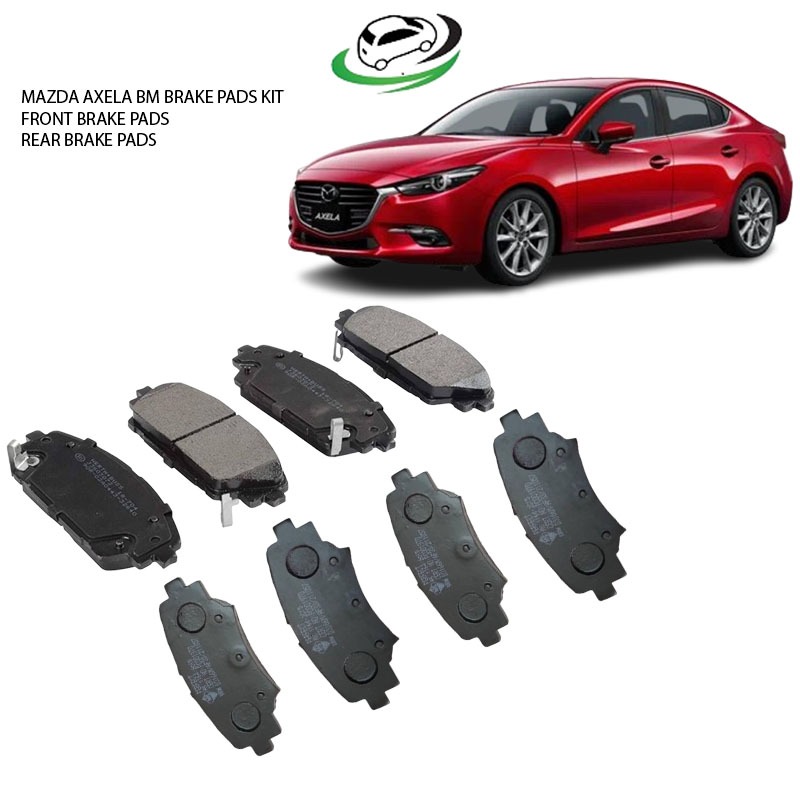-3%
Get Mazda Axela BM Front & Rear Brake Pad Kits D3163 / D3166
Brake pad kits are essential components of a vehicle’s braking system, which ensures the safety of the driver and passengers by allowing the vehicle to slow down or come to a complete stop. Brake pads play a critical role in this system by creating the necessary friction against the brake rotors, helping the vehicle decelerate effectively. Both the front and rear brake pad kits are important, though they function under different conditions due to the weight distribution and dynamics of braking in most vehicles.
This guide covers everything you need to know about front and rear brake pad kits, including their functions, differences, types, signs of wear, maintenance, and replacement.
Functions of Brake Pad Kits
- Friction Generation:
- Brake pads generate friction against the brake rotors when the brake pedal is pressed. This friction is what slows down the wheel’s rotation, allowing the vehicle to stop.
- Heat Dissipation:
- The braking process generates a significant amount of heat. Brake pads are designed to withstand and dissipate this heat to prevent brake fade, a condition where braking efficiency decreases due to excessive heat.
- Protection of Rotors:
- The materials in brake pads are softer than the brake rotors. This ensures that the brake pads wear out faster than the rotors, protecting the rotors from premature wear and reducing the overall cost of brake system maintenance.
- Noise Reduction:
- High-quality brake pad kits often come with features like anti-noise shims or coatings to reduce squealing or grinding sounds during braking.
- Safety Assurance:
- Most importantly, brake pads ensure the safety of the vehicle by providing reliable stopping power. Effective brake pads enhance vehicle control, especially in emergency situations.
Front vs. Rear Brake Pad Kits: Key Differences
- Braking Force Distribution:
- The front brake pads handle a larger portion of the braking force, typically around 60-70%, due to the forward weight transfer that occurs when braking. This means front brake pads tend to wear out faster than rear pads.
- Rear brake pads assist with braking but are not subjected to as much force. They help maintain vehicle balance and stability, especially in rear-wheel-drive vehicles or vehicles with Electronic Stability Control (ESC) and Anti-lock Braking Systems (ABS).
- Size and Design:
- Front brake pads are usually larger and thicker to handle the increased braking load. Rear brake pads, while smaller, are designed for consistent performance under lighter load conditions.
- Heat Tolerance:
- Since the front brake pads deal with more friction and heat, they are often made from materials that can handle higher temperatures without degrading. Rear pads, while also heat-resistant, do not require the same level of thermal capacity.
Types of Brake Pads
There are several types of brake pads, each with distinct materials, benefits, and applications:
- Organic Brake Pads:
- Made from non-metallic materials like rubber, glass, resin, and Kevlar, organic brake pads are known for their quiet operation and affordability. However, they wear out faster and are not suitable for high-performance or heavy-duty vehicles due to their lower heat resistance.
- Semi-Metallic Brake Pads:
- These brake pads are made from a mixture of metallic and organic materials. They offer better durability and heat dissipation than organic pads, making them ideal for most passenger cars. However, they may be noisier and cause more wear on the rotors.
- Ceramic Brake Pads:
- Ceramic brake pads are made from ceramic fibers and nonferrous materials. They offer excellent performance, are quieter, produce less brake dust, and have longer lifespans. Their only downside is their higher cost. Ceramic pads are best suited for high-performance vehicles or luxury cars.
- Low-Metallic NAO Brake Pads:
- These pads contain a small percentage of metal to improve heat transfer and braking performance. They are noisier than ceramic pads but provide good braking power and durability.
Signs of Worn Brake Pads
Over time, brake pads wear down due to constant friction against the rotors. It’s essential to recognize the signs of worn brake pads to avoid compromising vehicle safety. Common symptoms of worn brake pads include:
- Squeaking or Squealing Noise:
- Many brake pads are designed with a wear indicator that emits a squealing noise when the pads need to be replaced. If you hear consistent squealing when braking, it may indicate worn pads.
- Grinding Sound:
- A grinding noise usually means the brake pads have worn down completely, and the metal backing plate is rubbing against the rotor. This can severely damage the rotor and should be addressed immediately.
- Longer Stopping Distances:
- Worn brake pads reduce the vehicle’s braking efficiency, causing it to take longer to stop.
- Vibration or Pulsation:
- If the brake pads are unevenly worn or the rotors are warped, you may feel a vibration or pulsation when applying the brakes.
- Brake Warning Light:
- Some vehicles have a brake pad wear sensor that triggers a dashboard warning light when the pads are worn out.
Maintenance of Brake Pads
Maintaining brake pads is critical to ensuring they perform optimally and last as long as possible. Here are some maintenance tips:
- Regular Inspections:
- Brake pads should be inspected at least every 10,000 to 12,000 miles or whenever you notice any symptoms of wear. During routine maintenance, ask your mechanic to check the thickness of the brake pads.
- Keep Brake Components Clean:
- Brake pads and rotors should be kept clean and free of brake dust and debris. Contaminants like dirt or road salt can accelerate wear. Clean your brake components periodically or have them cleaned during regular maintenance.
- Brake Fluid Checks:
- While not directly related to brake pads, the condition of your brake fluid affects overall braking performance. Old or contaminated brake fluid can lead to poor brake pad performance and increased wear.
- Smooth Driving Habits:
- Avoid harsh braking whenever possible. Gradual braking helps to preserve the life of your brake pads. Driving with a heavy foot on the brake pedal, especially during city driving or downhill, accelerates wear.
Replacement of Brake Pads
Brake pad replacement is a standard part of vehicle maintenance. Depending on your vehicle type, driving habits, and the type of pads used, brake pads generally last between 25,000 to 70,000 miles. Here’s an overview of the replacement process:
- Preparation:
- The vehicle is lifted, and the wheels are removed to access the brake components. Ensure the vehicle is on a stable, flat surface, and use jack stands for safety.
- Inspecting Rotors and Calipers:
- Before replacing the brake pads, the brake rotors and calipers should be inspected for wear or damage. Warped or excessively worn rotors should be resurfaced or replaced to ensure proper braking performance.
- Removing the Old Pads:
- The caliper must be removed or unbolted to access the brake pads. The old brake pads are then pulled out from the caliper bracket.
- Installing New Pads:
- The caliper piston may need to be compressed to make room for the new, thicker brake pads. Once the new pads are positioned in the caliper bracket, the caliper is reattached, and the system is checked for proper fit.
- Brake System Testing:
- After the new pads are installed, the brake pedal should be pressed multiple times to ensure the caliper piston is in the correct position. The vehicle should then be taken for a test drive to ensure the brakes are functioning correctly.
Choosing the Right Brake Pad Kit
Selecting the right brake pad kit is vital for your vehicle’s performance and safety. Here are factors to consider:
- Vehicle Type:
- Choose brake pads that match your vehicle’s type and weight. High-performance or heavy vehicles may require ceramic or semi-metallic pads, while smaller cars might be fine with organic pads.
- Driving Conditions:
- If you drive in stop-and-go traffic or on hilly terrain, consider brake pads designed for higher heat resistance and durability. Ceramic or semi-metallic pads are better suited for such conditions.
- Budget:
- While ceramic pads offer the best performance and longevity, they are more expensive than organic or semi-metallic pads. Choose based on your needs and budget.
Conclusion
Front and rear brake pad kits are crucial components of your vehicle’s braking system. They are responsible for slowing down or stopping your vehicle by generating friction with the rotors. Understanding the different types of brake pads, recognizing the signs of wear, and maintaining them properly ensures your vehicle’s safety and prolongs the life of other braking components. Regular inspections and timely replacements are essential to prevent brake failure and maintain optimal braking performance.
Follow us on Facebook for more parts.




Reviews
Clear filtersThere are no reviews yet.